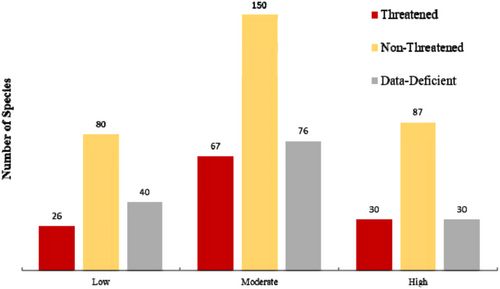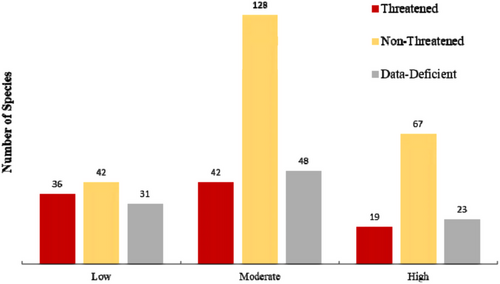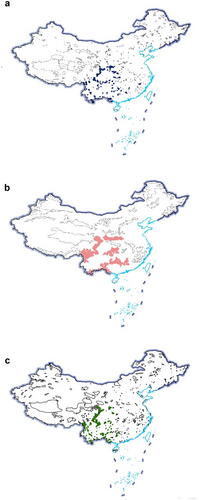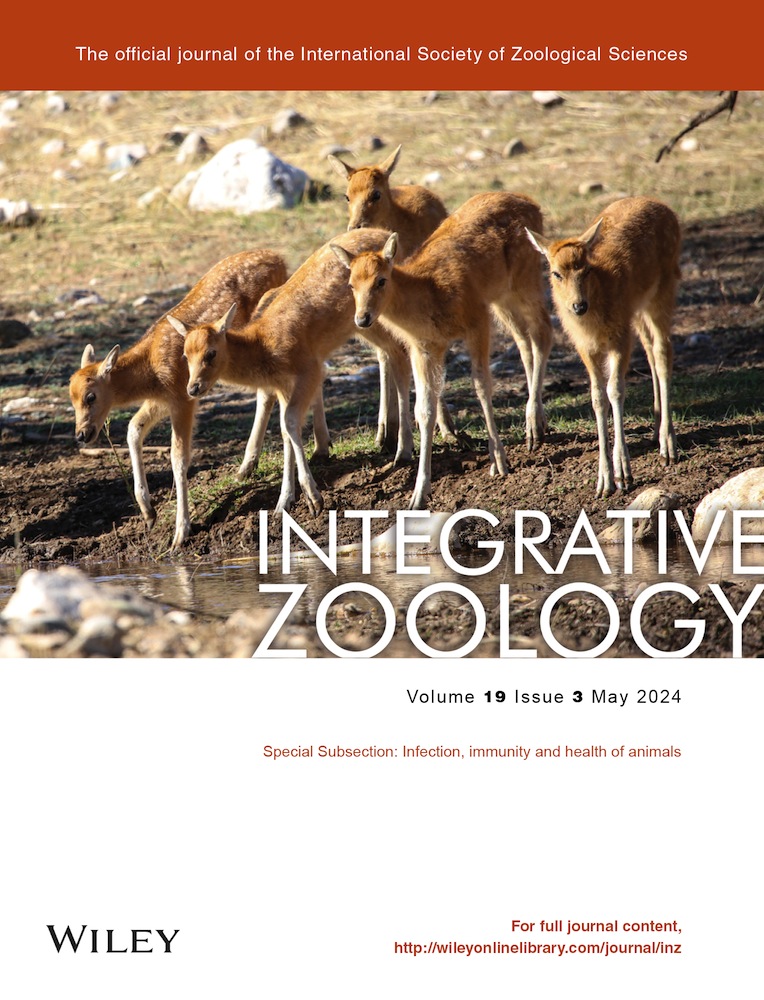Taxonomy, distribution, and contemporary exposure of terrestrial mammals to floods and human pressure across different areas for biodiversity conservation in China
Abstract
A significant research focus is placed on identifying animal species and areas at future risk to human-induced alterations of the environment and long-term changes in climatic conditions. Yet, the extent to which exposure to extreme climatic events and intense human pressure can increase the risk of harmful impacts on species remains poorly investigated. Focusing on terrestrial mammals in China, one of the world's megadiverse countries, we investigated patterns of contemporary exposure to floods and human pressures and determined their taxonomic representation and distribution across three major area-based conservation schemes, namely, national nature reserves (NNRs), priority areas for biodiversity conservation (PABCs), and key biodiversity areas (KBAs). Among the 440 species assessed with moderate or high exposure to floods, 327 (∼75%) also qualified as moderate or high in exposure to intense human pressure. These species mainly belong to the orders Chiroptera, Eulipotyphla, and Rodentia. Likewise, there were 305, 311, and 311 species with moderate or high exposure to flood and intense human pressure represented across NNRs, PABCs, and KBAs, respectively. Our findings support the prioritization of KBAs for expansion of site-based protection efforts such as NNRs in China, considering threats to species from exposure to adverse effects from both extreme climate and human pressure.
INTRODUCTION
The rate of species extinction has increased by 100 times over the past century compared to the average extinction rates over the past 10 million years mainly as a result of human pressure (IPBES 2019). Climate change has also contributed to this trend (Ramula et al. 2015; Gardner et al. 2016; Gynther et al. 2016; Scheffers et al. 2016; Woinarski & Burbidge 2016). If the current rise in global average temperatures reaches between 2°C and 3°C in the coming century, it is expected that between 20% and 30% of species may be lost in the same period (IPCC 2007; Trisos et al. 2020).
China has made major strides to protect, manage, and boost its biodiversity in recent decades (Lui & Li 2005; Li et al. 2010; Huang et al. 2020; Wan et al. 2020; Mi et al. 2021; Shuai et al. 2021). Among the 17 world's megadiverse countries, the biodiversity conservation strategy and action plan of China (period 2011–2030) places as top priority the protection of ecosystems, species, and genetic resources to ensure ecological security while advancing social and economic development (CNBCSAP 2010). Nonetheless, many challenges still remain. Approximately 26% of the total extant mammal species have been assessed as threatened in the China's Red List of Biodiversity (Jiang et al. 2021), with over-exploitation, habitat destruction, and human development among the leading drivers of risk (Hughes 2017; Huang et al. 2020; Jiang et al. 2021). Worryingly, changes in regional climate conditions, including changes in extreme climatic events (ECEs) are expected to contribute further risk to mammals and other vertebrates already threatened by human pressure (Fang et al. 2018; Ameca et al. 2019).
Against this background, national nature reserves (NNRs) have been fundamental to protect mammal biodiversity in China and hold a great potential to confront the adverse effects from climate change (Xu et al. 2017; Zhang et al. 2017; Huang et al. 2020). In addition to NNRs, key biodiversity areas (KBAs) delineated within the country have the dual benefit to target wildlife populations that can disproportionally contribute to the global survival of species while also targeting areas providing critical ecosystem services such as climate regulation and moderation of regional weather patterns (Kullberg et al. 2019). At a broader scale, terrestrial priority areas have been delineated aiming at further protecting ecosystem integrity and the species they harbor from human influence as well as improving their adaptive capacity to respond to climate change (MEP 2015). These priority areas for biodiversity conservation (PABCs) include all NNRs and a majority of KBAs covering about 29% of the total land area of the country.
In similarity with other megadiverse countries, designing and implementing mitigation and adaptation strategies to tackle climate change while reducing human pressure remain major challenges to halt biodiversity loss in China. The national biodiversity conservation strategy and action plan acknowledges the importance of enhancing existing capacities (CNBCSAP 2010). In this context, the identification of animal species most at risk of experiencing both climate and human pressures relative to the location of area-based conservation strategies can help advance such a national strategy. All else being equal, these areas comprising populations of species currently exposed to both climate and human pressures should be given priority for implementing mitigation and adaptation actions using existing capacities within areas of biodiversity importance.
Floods are increasing in frequency and intensity in recent decades (Seneviratne et al. 2012; Hirabayashi et al. 2013), and their impacts have been documented across diverse taxonomic groups (Ameca & Jiang 2016; Ponting et al. 2021; Zhang et al. 2021). Die-offs of wildlife populations represent a potential immediate and direct consequence of flooding due to drowning or, in the flood's aftermath, due to hypothermia, malnutrition, and stress (Williams et al. 2001). Indirect consequences can result from habitat degradation which compromises access to high-quality food and shelter to many species, making them more prone to risk factors from human origin (Heinrichs et al. 2016). Regionally, heavy precipitation and associated flooding are projected to intensify and become more frequent in Asia with a 1.5°C increase in global temperatures (IPCC 2021). These predictions hold true in China which is observing a sevenfold increase in flood frequency in some regions (Ding & Dong 2005; Wang et al. 2019). Terrain slope and permeability as well as accelerated land transformation caused by human activities in China enable more frequent and prolonged floods, underscoring the need for identifying areas where risk of exposure to high magnitude environmental disruptions is particularly high (GCRI-BMI 2009).
Here, we investigated patterns of current exposure to floods and intense human pressure across the distribution of 590 terrestrial mammal species in China, with particular attention to their representation across three major area-based conservation schemes in the country, namely, NNRs, KBAs, and priority areas for biodiversity conservation and protection (PABCs) (see Fig. S1, Supporting Information). Specifically, we answer the following questions: To what extent are mammal species currently exposed to both floods and intense human pressure? and how well do the three different area-based conservation schemes capture species that are moderately or highly exposed to both types of pressures?
MATERIALS AND METHODS
We used ArcMap software (Version 10.5; ESRI 2016) and R software (Version 4.0.3; R Core Development Team 2020) for all geospatial and statistical analyses.
Species datasets
We used the distribution maps (available as shapefiles) of terrestrial mammal species in China from the IUCN Red List of Threatened Species (Accessed June 2021, IUCN 2021) and adopted the risk categories from the China's Red List of Biodiversity (Accessed June 2021, Jiang et al. 2021). Changes in the geographical distribution of species can serve as an indirect indicator to investigate their risk of population decline (Collen et al. 2011; Venter et al. 2014). However, populations of species are not evenly distributed across their range; some species can have extremely dense or extremely sparse populations (Gerritsen 1980; Steinmeyer et al. 2012). Likewise, records of species presence vary temporally, with some locations associated with relatively more recent sightings than others. The IUCN mapping standards classify the degree of certainty of a species presence across its geographic distribution. Following the IUCN mapping standards, we focused on areas categorized as “extant” to avoid overestimating current exposure to climate and human pressures in spatial analyses. These areas represent locations where species’ populations are known or thought very likely to occur currently in the area, encompassing localities with current or recent (last 20–30 years) records where suitable habitat at appropriate altitudes remains (IUCN 2019). Following the China's Red List of Biodiversity, we grouped mammal species as “Threatened” (critically endangered, endangered, and vulnerable; n = 123 species) and “Non-threatened” (near threatened and least concern; n = 318). There are 46 mammals listed as data deficient. In addition, the conservation status of 103 mammal species within China has not been assessed in its national Red List. These species were included in the analysis but their conservation status was considered as data deficient. Furthermore, one species (Equus ferus) was excluded because it is considered extinct in the wild in China. Overall, 590 mammal species belonging to 11 Orders and 42 families were considered for the analysis (Fig. S1, Supporting Information).
Flood data
Frequency and spatial distribution of flood extents (available as shapefiles) were extracted from the Dartmouth Flood Observatory (DFO) (Accessed June 2021, Brakenridge 2021). The DFO uses orbital remote sensing to detect floods supplemented by news reports and satellite imagery to measure and draw bounding polygons per flood event. This study makes use of individual flood events in China for a 30-year time interval (1991–2021) (Fig. S1, Supporting Information), which concurs with the time period for which species distributions used in our analysis are classified as extant by the IUCN.
Human pressure data
We used the 2009 human footprint index (HFI) (Accessed June 2021, Venter et al. 2016) to extract information on intense human pressure across the distribution of the 590 mammal species. At a spatial resolution of 1 × 1 km2, the HFI measures the cumulative impact of direct pressures on environment from human activities and is based on data from built environments, agricultural lands, pasture lands, human population density, night-time lights, railways, roads, and navigable waterways covering the period 1980–2009 (see Table S1, Supporting Information). We delineated polygons with HFI values ≥7, which are associated with “intense” pressure (Jones et al. 2018) and examined levels of overlap with the distribution of individual species (see below).
Area-based conservation schemes data
The spatial data of the 449 NNRs and 32 terrestrial PABCs were obtained from the Ministry of Ecology and Environment of China (Accessed June 2021, MEP 2015). The spatial data of the KBAs came from the World Database of Key Biodiversity Areas (Accessed June 2021, IUCN 2018). In total, 615 terrestrial KBAs found in China were kept for the analysis. Individual NNRs, PABCs, and KBAs were all available as shapefiles.
Quantifying species exposure to floods
We defined flood exposure as the degree to which the spatial extent of individual flood events overlays the extant geographic distribution within which individual species occur (Ameca et al. 2013). Likewise, we assumed that the exposure to environmental disturbances associated with floods within the 30-year time period could cause disruption of ecosystem processes or functions upon which the species’ populations rely on (Shabarova et al. 2021) and limit the opportunities of recovery from population die-offs that occurred as a result of the direct mortality from a first event and lessen the resilience of survivors against further disturbance (Ameca et al. 2012). In this stage, we overlapped the extant distribution of each species one by one with the layer of flood events using the “intersect” tool in ArcMap and then obtained the proportion of each species distribution that has been exposed to floods for the period 1991–2021. Then, we generated a flood exposure score (FES) with the sum of areas within a species distribution that have been exposed to individual floods during such time window. After ranking all the species based on their respective FES, we classified them as having “low,” “moderate,” or “high” flood exposure provided that they ranked in the lower quartile, the interquartile range, or the upper quartile of all the species assessed, respectively. We use the lower-upper quartile data aggregation approach because it makes a more robust representation of how data values (exposure scores) are distributed compared to other approaches; this approach has been used previously in conservation planning and climate change biology at different scales (Araújo et al. 2005; Kuempel et al. 2019; Muller et al. 2019; Frota et al. 2021).
Quantifying species exposure to intense human pressure
We defined exposure to intense human pressure as the degree to which the spatial extent of areas with high values on the HFI overlapped with the distribution of species. Focusing on the geographic distribution of the 590 mammal species, we targeted HFI values ≥7, which are associated with “intense” human pressure (Jones et al. 2018). These values are considered as a single scale of intense human pressure. We identified species having “low,” “moderate,” and “high” exposure provided that they ranked in the lower quartile, the interquartile range, or the upper quartile of all the species assessed based on the proportion of their extant distribution subject to these high values of the HFI.
Quantifying species exposed to floods and human pressure across different area-based conservation schemes
The distribution of species assessed as having moderate or high exposure to both floods and intense human pressure was overlapped one by one, with NNRs, KBAs, and PABCs. We rationalize that exposure to both pressures over such proportion of a species range can be more harmful for a large proportion of their populations and should merit particular consideration for management and monitoring. For the three types of areas, we ranked each type (e.g. NNRs) by the number of species represented within their boundaries and defined those within the upper quartile as priority areas to tackle flood and human-induced disturbance. This procedure allowed us to compare the effectiveness of the three types of area-based conservation schemes in terms of the representation of species more at risk from these pressures.
RESULTS
Mammal species in China exposed to floods
Of the 590 mammal species assessed, 147 (∼25%) qualified as highly exposed to floods with the orders Carnivora, Chiroptera, and Rodentia having the largest taxonomic representation; overall, 20% of the 147 species are listed as threatened, 59% as non-threatened, and 20% as data deficient in the China's Red List of Biodiversity (Fig. 1). In addition, 293 species (∼ 50%) were assessed with moderate flood exposure mainly belonging to the orders Chiroptera, Rodentia, and Eulipotyphla; 23% of these species are listed as threatened (n = 67, mainly from the orders Carnivora and Primates) and 51% as nonthreatened (n = 150, mainly from the orders Rodentia and Eulipotyphla) (Fig. 1). Finally, 146 species qualified as having low flood exposure; the taxonomic identity of these species lies mainly within the orders Chiroptera, Rodentia, and Lagomorpha. Of these species, around 55% (n = 80) are listed as nonthreatened and 18% (n = 26) as threatened, with the remaining 27% (n = 40) as data deficient.

How many flood-exposed mammals are also exposed to intense human pressure?
Our results show that among the 440 species assessed with moderate or high exposure to floods, 109 (∼25%) also qualified as highly exposed to intense human pressure. These species mainly belong to the orders Chiroptera, Eulipotyphla, and Rodentia, with 17% of these species listed as threatened, 61% as non-threatened, and 21% as data deficient in the China's Red List of Biodiversity.
Likewise, 218 (∼50%) of mammals with moderate or high flood exposure were assessed with moderate exposure to intense human pressure, with a taxonomic representation also biased toward Chiroptera, Eulipotyphla, and Rodentia. The majority of these species (59%) are red-listed as non-threatened (n = 128, mainly from Rodentia and Eulipotyphla orders) and 19% as threatened (n = 42, mainly from Carnivora and Chiroptera order) (Fig. 2). Among the 440 species assessed with moderate or high exposure to floods, 327 (∼75%) also qualified as moderate or high in exposure to intense human pressure.

We also identified 109 species with moderate or high exposure to floods that qualified as having low exposure to intense human pressure. These species mainly belong to the orders Carnivora, Chiroptera, and Rodentia, with 33% (n = 36) flagged as threatened and 39% (n = 42) as non-threatened (Fig. 2). In addition, four flood exposed mammals (Nyctalus montanus, Eoglaucomys fimbriatus, Anourosorex schmidi, and Crocidura horsfieldii) were not exposed to intense human pressure.
The performance of NNRs, PABCs, and KBAs in capturing species exposed to both floods and intense human pressures
There were 305 species assessed with moderate or high exposure to both flood and intense human pressure represented within the network of 449 NNRs. These species mainly belong to Rodentia (n = 98), Chiroptera (n = 88), Eulipotyphla (n = 49), and Carnivora (n = 26); 19% (n = 57) of them are red-listed as threatened, 63% (n = 191) as non-threatened, and 19% (n = 57) as data-deficient (Fig. 3c). In total, 112 NNRs have the largest representation (in the upper quartile) of these species (Dataset S1, Supporting Information).

The network of 32 PABCs captured 311 species with moderate to high exposure to both floods and intense human pressure within their bounds. The taxonomic representation of these species lay mainly within Rodentia (n = 99), Chiroptera (n = 95), Eulipotyphla (n = 49), and Carnivora (n = 26). Of these species, 18% (n = 57) are listed as threatened, while 62% (n = 192) are listed as non-threatened, along with 20% (n = 62) species that are data deficient. The eight PABCs capturing the greatest representation (in the upper quartile) of these species (n = 265) were: Southern Section of Hengduanshan Mountain Area, Xishuangbanna Area, Northern Section of Minshan-Hengduanshan Mountain Area, The Mountain Area of Southwest Guangxi, Wuling Mountain Area, Nanling Mountain Area, Qinling Mountain Area, and the Limestone Area of West Guangxi and South Guizhou (see Dataset S1, Supporting Information).
The network of 615 KBAs in China includes 311 mammal species with moderate or high exposure to flood and intense human pressure. These species mainly belong to the orders Rodentia (n = 102), Chiroptera (n = 91), Eulipotyphla (n = 48), and Carnivora (n = 26). Of these 311 species, 62% (n = 194) were listed as nonthreatened, 19% (n = 58) as threatened, and 19% (n = 59) as data-deficient. Figure 3a shows the 163 KBAs having the largest representation of species (in the upper quartile) relative to the total 615 KBAs assessed in the country. The list of these KBAs together with the species they contain is shown in Dataset S1, Supporting Information.
DISCUSSION
There is a growing threat to biodiversity from both climate and human pressures (IPCC 2021). An increased exposure to their impacts on species and their habitats calls for conservationists, planners, and wildlife managers to redouble efforts to protect them. Here, focusing on one of the world's megadiverse countries, we assessed to what extent the distribution of terrestrial mammals is currently exposed to both flood and intense human activities, what is the taxonomic identity of these species, and how well does three major area-based conservation schemes cover portions of the species’ distribution affected by these pressures. The risk assessment of areas of potential interaction between climate and human risk factors is still in development (Brooks et al. 2007). In China, such an assessment is imperative to better inform spatial prioritization and, ultimately, achieve species conservation targets in areas of biodiversity importance while moving toward halting and reverting global biodiversity loss (Leclère et al. 2020; Wang et al. 2020).
A large proportion of mammals in China (75% of the total 590 species assessed) are facing moderate or high exposure to floods, with species from the orders Rodentia and Chiroptera taking the largest representation (n = 210 and n = 142, respectively). The mean geographic distribution of rodent species in China (∼68 km2) is slightly higher than that of bats (∼63 km2). Despite Rodentia exhibiting a larger proportion of flood exposed species than Chiroptera, the latter comprises a larger number of species assessed as highly exposed to floods. Bats do have a larger representation of species in Southern China compared to rodents (Feijó et al. 2019), a region which according to our analyses has experienced the highest flood frequency within the past three decades (see Fig. S1, Supporting Information), making bats the mammal group currently facing higher risk of exposure to floods. Bats are expected to avoid direct exposure to flooding, yet indirect impacts can come as a result of destruction of roosting and foraging sites (O'Shea et al. 2016; Bobrowiec et al. 2021). With forecast of more frequent and intense flooding events (Ding & Dong 2005; Wang et al. 2019), it is expected that the augmented environmental disturbance may surpass bats’ adaptive capacities, making them more threatened than currently recognized.
The IUCN Red List of Threatened Species provides assessments of risk factors to species survival with guidance from a threat classification scheme. There are six terrestrial mammal species that have been assessed as having impacts from flooding through this scheme (IUCN 2022) that we found with high flood exposure within China. Of these species, the hog deer, Axis porcinus, is reported to be affected by both floods and human activities (Jiang et al. 2021). The spatial overlap of different risk factors across a species distribution can also have adverse consequences in species with sympatric distribution, particularly if they share similar habitat preferences. In this context, we argue that there might be populations of other mammal species across the range of the hog deer (e.g. Chinese Serow, Capricornis milneedwardsii), which may currently be confronting adverse effects from flooding, but are yet to be flagged as threatened. This may also be the case for the water deer (Hydropotes inermis), the black muntjac (Muntiacus crinifrons), and sika deer (Cervus nippon), which we found highly exposed to floods and human pressure in our spatial analyses. Flood frequency is expected to grow in the coming decades (Wang et al. 2019; Chen et al. 2021; CMA-CCC 2021), which may pose greater challenges for species conservation prioritization. Against this backdrop, we encourage further field monitoring to validate the outcome of our analyses of exposure to guide tailored management interventions as they are expected to vary depending on the local context. These actions can promote sustainable land use practices (e.g. agroforestry, organic farming, and low-input agriculture) and restoration of degraded ecosystems (e.g. removing invasive species, planting native catchment vegetation) (Schindler et al. 2016) that can benefit both people and wildlife.
We found that there is high congruence in the number and identity of mammal species with moderate or high exposure to both floods and intense human pressure represented across NNRs, PABCs, and KBAs (Fig. S2, Supporting Information). This is because NNRs and KBAs have a similar regionalization and aerial extent and most of such an area is contained across the network of PABCs. PABCs were designed considering the representativeness of an array of biodiversity features and ecosystems, taking into account their economic, cultural, and research value. They act as a guiding mechanism to influence local biodiversity conservation policies and are ideal for the expansion of protected landscapes in the form of national-level managed nature reserves which have the strictest level of protection in the country (Zhang et al. 2017). Key biodiversity areas harbor critical populations of the world's threatened species, and a large proportion of these areas are not fully covered by nature reserves as it is the case in China. Our findings support further prioritization of KBAs for expansion of NNRs on the basis of the representation of mammal diversity currently facing a high level of exposure to extreme climate and human-induced disturbance. We hope that our study will encourage researchers to further examine the consequences of increased exposure to climate and human pressures across areas of biodiversity importance, advance efforts toward better understanding the mechanisms by which species are being affected, and implement actions that can promote sustainable land use practices and restoration of habitats to benefit both people and nature.
ACKNOWLEDGMENTS
We acknowledge Z. Jiang for facilitating access to the species conservation status of terrestrial mammals used in this study, and R. Brakenridge for facilitating access to flood data. Z. Wang, and E.O. Ameca provided valuable comments on previous drafts of this study. We also thank the editor for constructive comments, which greatly improved this study. This work was supported by a research fund from Beijing Normal University to E.I.A. which supports the studentship of R.S.
CONFLICT OF INTEREST
The authors declare no conflicts of interest.




